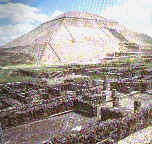|
|
In the early pre-Classic period, Maya society was composed of family groups that shared the same language, customs and territory. They gathered together to cultivate the land, to fish, hunt and collect food for survival. Later, when agriculture was more developed, irrigation systems were built and crops diversified, some of them to be traded.
The population grew considerably, great ceremonial centers were begun, and the ordinary people settled around them. Different social classes arose as a result of the division of labor.
Number of cities and ceremonial centers increased in Classic period. In them lived the ruling class, devoted to government, priests and specialists in the arts of magic, warriors and merchants, as well as architects, who were responsible for planning temples, places and public buildings, astronomers, who observed the movement of the heavenly bodies and tried to discover the harmony of Universe and recurring cycles of time, and the scribes, whose job was to record important historical events, mythical and religious beliefs, the genealogies of rulers and exploits of warriors in codices, using complex system of hieroglyphic writing.
At an intermediate level, there were builders, servants of ruling class, potters and other craftsmen. Finally, there was the lower class formed of fishermen, hunters and farmers, who lived on the outskirts of cities and ceremonial centers. There were also slaves, called Pentacoob in Maya, who were generally prisoners of war, the children of slaves, or orphans.
At the end of Classic period and throughout Post-Classic, this division into social classes continued although religious and political powers, formerly in hands of single person, were divided. Rulers were headed by "Halach Uinic" (True Man), and priests by "Ahua Can" (Lord Serpent), each with defined tasks.
Maya-Toltec or Mexica period saw the arrival of Nahua speaking groups, bringing Toltec culture from central Mexico to Yucatan peninsula. They exerted their influences on both material culture and customs. Finally, in the period of Mexica Absorption, wars and uprisings led to the destruction of social organization and abandoning of cities.

|
|

